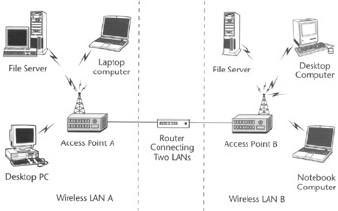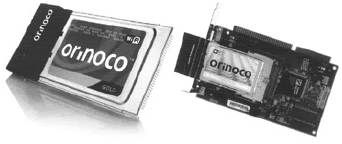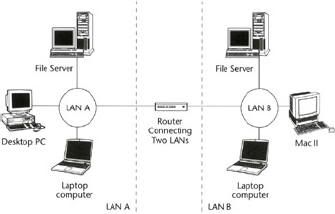In this part, we talk about estimating the required hardware and software that you will need to deploy your wireless LAN successfully.
Basic Wireless LAN Hardware
The wireless LAN hardware that you might need will depend on your deployment scenario. You should plan on using the hardware that suits your requirements, is right for your budget, and is upgradable in future. Let's talk about some of the most commonly used LAN equipment in a wireless LAN deployment.
Access Points (APs)
Access points are considered to be the heart of wireless LANs as they facilitate the data transmission among computers in a network.
The AP devices are wireless−LAN−technology specific, and an AP based on one technology normally does not operate with another technology. For example, an 802.11b wireless LAN adapter does not work with an 802.11a−based AP.
It is important to realize that a wireless LAN that consists of 802.11b is a totally separate LAN from one constructed using the 802.11a technology, even if they share exactly the same physical area. A carefully conducted site survey should help you plan the number of APs that are needed at a site.
If your site survey suggests that you need a hybrid wireless LAN where both 802.11b and 802.11a devices must coexist, you should plan to connect the APs forming two distinct LANs and interconnect the two LANs using a wired LAN technology (see Figure 1).
This will ensure that even though you have built a hybrid LAN, users on either LAN can communicate with each other.
Wireless LAN Adapters
Wireless LAN adapters or wireless network interface cards (wireless NICs) are devices that individuals use with their wireless computing devices to participate in a wireless LAN. Just like APs, wireless LAN adapters are technology specific and must be carefully chosen based on the LAN requirements and the AP technology.
Per−site user and device profiling should help you estimate the number of wireless LAN adapters that you will need. The wireless LAN adapters will be different for mobile devices (for example, notebooks and PDAs) and desktop workstations.
Mobile devices will generally require PC Card Interface Adapter−based wireless LAN adapters, whereas desktop workstations would typically need Peripheral Component Interconnect (PCI)−based wireless LAN adapters. Depending on the deployment, plan on using the type of wireless LAN adapters that fit your needs.
Figure 2 shows some of the most commonly used LAN adapters.
Routers
Routers are the devices that act as a police officer guiding traffic between two or more LANs. For example, if a wireless LAN consists of 100 computers and 50 of these computers belong to department A and the other 50 to department B.
Assuming that the computers in the two departments do not necessarily communicate with each other as much as they communicate with computers within their department, it is a good idea to build two separate wireless LANs, A and B.
A network divided this way provides higher performance as each LAN is now standalone and does not interfere with traffic from the other. If communication between networks A and B is desired, they can be interconnected using a router.
The router will intelligently send data packets from LAN A to LAN B only if a data packet originating in LAN A is intended for a computer in LAN B. This routing of LAN traffic is illustrated in Figure 3
Some APs do come with built−in routers to help separate wireless LANs from wired LANs. If you are planning a standalone wireless LAN that consists of a few computers—for example, 10 or fewer—you might not need a router.
However, if you are planning to interconnect a wireless LAN with a wired LAN or to the Internet, you should use a router to isolate the two LANs.
Hubs
Hubs are wired LAN devices that extend a LAN by adding more physical connection points on a LAN (that is, RJ45 LAN Jacks). You might need to plan using one or more hubs if you are planning a LAN that will contain a substantial number of wired LAN computers.
Firewalls
Firewalls are highly configurable network devices that can be programmed to allow only restricted traffic to flow through networks. The use of firewalls is extremely important if you are connecting a LAN to the Internet. You should plan on using firewall equipment if your intended LAN interconnects two or more LANs especially over the Internet.
Broadband Connectivity Devices
The broadband connectivity hardware connects a LAN to a broadband connection, for example a digital subscriber line (DSL) modem connects a LAN to the Internet.
Each type of broadband connectivity requires a different type of hardware, and it can be obtained from the service provider of the broadband connection. Plan on obtaining such a device if you intend to provide broadband connectivity to your wireless LAN.
Software
You should plan on acquiring operating systems and the drivers for each type of wireless LAN adapter and the operating system that you will be using.
The wireless LAN adapter manufacturers usually ship the software drivers along with the adapter, or these can be downloaded from the manufacturer Web site for most popular operating systems.
When planning to use a certain type of wireless LAN adapter, make sure that the vendor of the wireless LAN does provide support and software drivers for the operating systems that you will be using.
For example, if you are planning to use wireless LAN adapters with Microsoft Windows XP, make sure that the manufacturer of the wireless LAN adapter supplies the drivers and other necessary software.
Conventional Hardware Requirements for Various Deployment Scenarios
In this section, we talk about the most popular hardware requirements of home, SoHo, enterprise, and WISP deployment scenarios. This section may help you plan your particular wireless LAN hardware needs.
Home
Home deployments of wireless LANs are the simplest and often require the least hardware. You will need the following for a simple wireless home LAN:
- Wireless LAN adapters. You will need one wireless LAN adapter for each computer or handheld device that will be participating in a LAN.
- Wireless LAN APs. You will need one or more APs to provide LAN connectivity.
- Broadband connection device, network router, and firewall. DSL or cable modem, router, and firewall are necessary to provide a safe connection to the Internet. Many manufacturers are selling APs that have built−in routers and firewalls and can be easily plugged into the broadband connectivity hardware.
- Wired LAN cables. You might also need some wired LAN connectivity for connecting stationary LAN devices like network printers with the AP. Most APs normally provide direct physical LAN jacks for connecting with such devices.
Small Office, Home Office (SoHo)
The small office, home office (SoHo) deployment scenarios are similar to those of home deployments except they often contain one or more file servers and require higher security. Plan on setting up proper security and deploying file servers when establishing a wireless LAN in a SoHo environment.
Wireless Internet Service Providers (WISPs)
The wireless Internet service providers (WISPs) provide wireless Internet services at public places like coffee shops, airports, and shopping malls. WISPs normally provide these services by installing APs at public places and connecting the APs with a broadband connection like DSL.
If you are planning to establish a WISP hotspot (point−of−service), you should have at least the following equipment installed at every site where you intend to provide WISP services:
- Wireless LAN APs. APs to provide wireless LAN connectivity to the end−users.
- Broadband connection device. WISPs only provide access to the Internet and normally do not provide any wireless LAN security. Under most circumstances, the broadband connection device is directly connected to the APs to provide a data path to the Internet.
- WISP account management software. WISP services are normally not free and require a fee to access the Internet. In order to account for the service usage and authentication, WISPs normally deploy account management software that monitors usage and bills a customer credit card for the charges incurred.
There are not many well−known accounting software companies that provide such software and services. Therefore, WISPs normally employ software engineers who write programs to manage the user accounts.
These programs are normally installed at the WISP hotspot or at a remote site that is connected with the hotspot. A WISP deployment can be illustrated as shown in Figure 4.
Enterprise
Enterprise wireless LAN deployments are the most complicated deployment scenarios. Enterprise requirements normally include connectivity to the Internet and with other corporate branches, the support for both wired and wireless LANs, and high security.
The following are important factors to consider when planning a wireless LAN for an enterprise:
- Wireless LAN adapters. You will need one wireless LAN adapter for each computer or handheld device that will be participating in a LAN. Plan on acquiring various different types of wireless LAN adapters as your site survey suggests
- Wireless LAN APs. You will need many APs to provide wireless LAN connectivity.
- Broadband connection device and network router and firewall. Enterprise LANs normally have higher speed requirements than home or SoHo users and often use various different types of equipment within a network. Plan to acquire network routers and firewalls to provide adequate security that is mandated by the enterprise policies.
- Wired LAN cables and miscellaneous hardware. Enterprise LANs have higher data throughput requirements that cannot be achieved using the current wireless LAN technologies.
Enterprise LANs almost always use wired LANs in network segments and users that require high network bandwidth, whereas the network segments and users requiring lower throughputs are connected using the wireless LAN equipment.
- Security measures. Wireless LANs must ensure that the best available security measures are used to protect the privacy of data traveling in a wireless LAN.



